Though Jesus is often portrayed as a light-skinned man with long hair and a beard, the real face of the Son of God was probably very different.
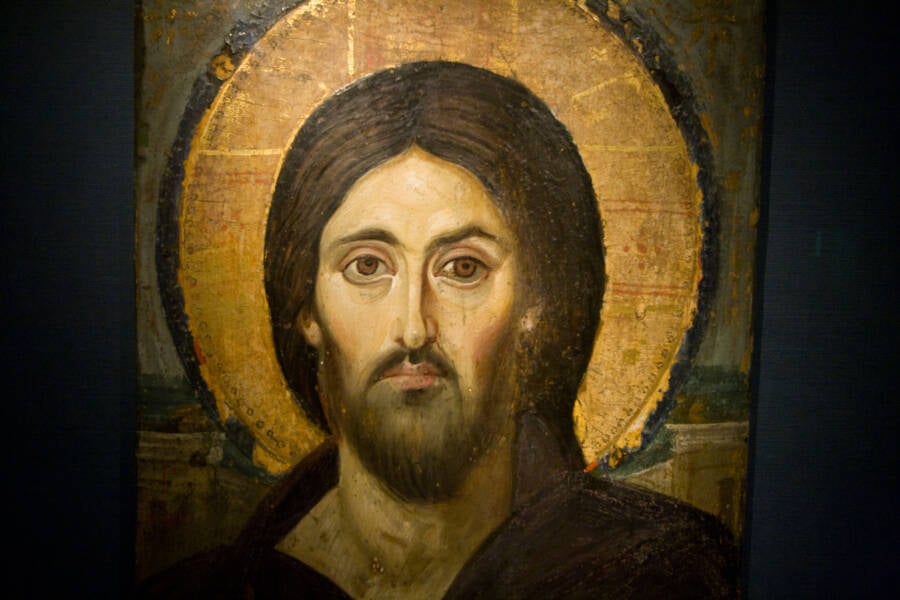
Madeleine Jettre/Alamy Stock PhotoA painting from St. Catherine’s Monastery in Egypt showing what Jesus may have looked like.
The Bible says very little about what Jesus looked like. And for centuries after his death, likely due to concerns about idolatry, artists wouldn’t even create depictions of the Son of God. So, the question has long remained: What did Jesus look like?
Iconic artistic depictions of Jesus, such as Leonardo da Vinci’s The Last Supper or Michelangelo’s The Last Judgement, look nothing like a typical first-century Jewish man in the Roman province of Judea. While we have little solid evidence of what the real face of Jesus looked like, he probably did not resemble the paintings hanging in most Western churches and museums to this day.
So what did the Christian savior look like? Artists, archaeologists, forensic scientists, and others offer a slew of fascinating answers to this eternal question.
- The Biblical Interpretation Of Jesus’ Appearance
- What Did Jesus Look Like Throughout History And How Have The Depictions Changed?
- The Scientific Interpretation Of Jesus’ Physical Appearance
- Historical Evidence Paints The Most Accurate Picture Of Jesus
The Biblical Interpretation Of Jesus’ Appearance
How Does The Bible Describe Jesus’ Physical Appearance?
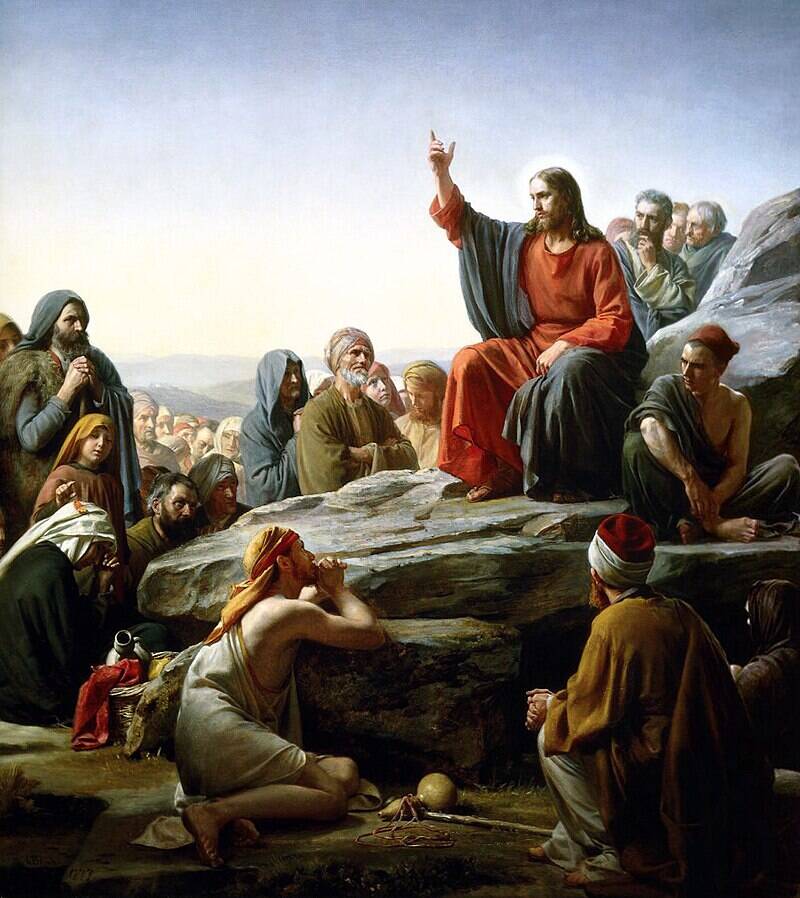
Public DomainPainting of Jesus’ Sermon on the Mount.
The Bible contains several intriguing passages about Jesus’ appearance, with both literal and symbolic meanings.
In the Book of Isaiah, Jesus is described as being physically unremarkable:
“For he grew up before him like a young plant, and like a root out of dry ground; he had no form or majesty that we should look at him, and no beauty that we should desire him.”
But what exactly were his unremarkable features? Bible passages like Luke 19:3-4 state that he did not stand out in a crowd and was particularly small:
“And he was seeking to see who Jesus was, but on account of the crowd he could not, because he was small in stature. So he ran on ahead and climbed up into a sycamore tree to see him, for he was about to pass that way.”
Strangely, these passages are the most thorough descriptions of Jesus in the Bible. There is no in-depth description of his facial features or body beyond brief details, leading to the puzzling question: why isn’t there more?
What The Bible Doesn’t Say About How Jesus Looked
The Bible shies away from giving its readers a full picture of what Jesus looked like, and for good reason.
In 1 Samuel 16:7, God tells Samuel, a prophet of the Old Testament, “Do not look on his appearance or on the height of his stature, because I have rejected him. For the Lord sees not as man sees: man looks on the outward appearance, but the Lord looks on the heart.”
As the son of God, Jesus was not meant to be worshipped for his flowing locks or his sharp jawline; instead, followers were meant to focus on his methods and teachings.
The lack of a physical description of Jesus in the Bible adheres to Christian beliefs about vanity and modesty and serves as a reminder for followers to reflect on their own priorities.
Did Jesus Have Long Hair And A Beard?
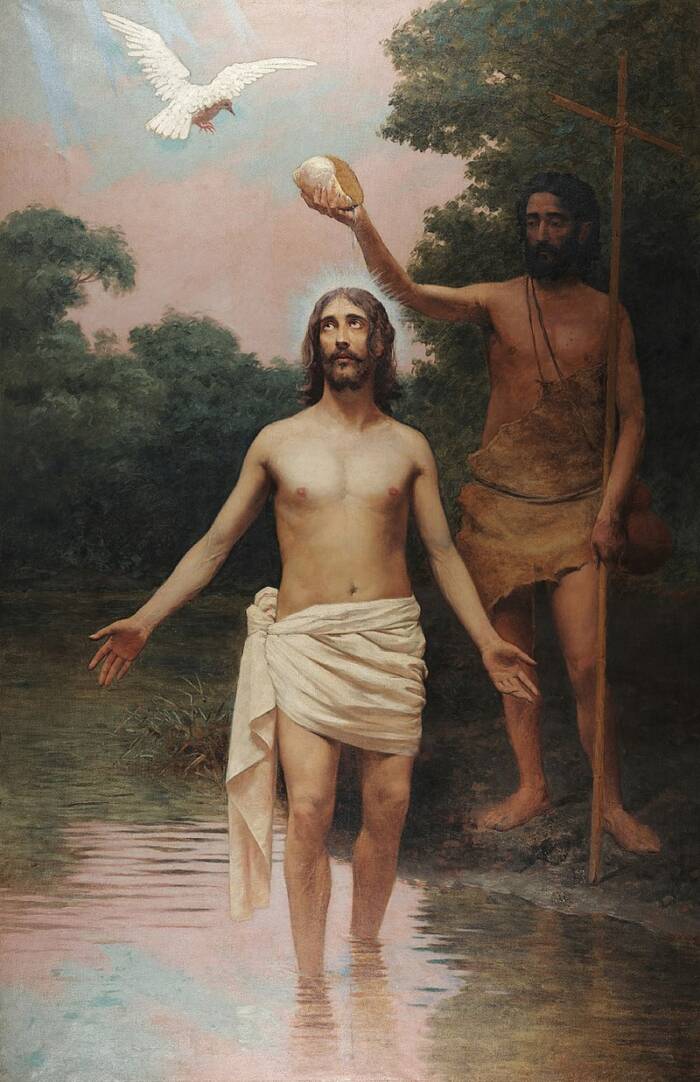
Public DomainPainting of Jesus being baptized by John the Baptist.
One of the most pressing questions about Jesus’ physical appearance is whether he had long hair and a beard.
According to the Bible, Jesus likely had a beard, as was common for men in Judea:
“You shall not round off the hair on your temples or mar the edges of your beard” – Leviticus 19:27
“I gave my back to those who strike, and my cheeks to those who pull out the beard; I hid not my face from disgrace and spitting” – Isaiah 50:6
However, it is unlikely that Jesus had long hair due to its association with women and femininity:
“Does not nature itself teach you that if a man wears long hair it is a disgrace for him, but if a woman has long hair, it is her glory? For her hair is given to her for a covering” – 1 Corinthians 11:14-15
The Use Of Symbolism In Biblical Texts

Public DomainA 19th-century depiction of the transfiguration of Jesus.
The Bible features a balance of both literal and figurative descriptions of events, ideas, and people. Jesus is no exception, but it does make pinpointing his physical appearance more difficult.
In Ezekiel 40:3, Jesus is described as bronze-skinned:
“When he brought me there, behold, there was a man whose appearance was like bronze, with a linen cord and a measuring reed in his hand. And he was standing in the gateway.”
Then, In Daniel 10:5-6, Jesus is described once again as having bronze skin and eyes like fire:
“I lifted up my eyes and looked, and behold, a man clothed in linen, with a belt of fine gold from Uphaz around his waist. His body was like beryl, his face like the appearance of lightning, his eyes like flaming torches, his arms and legs like the gleam of burnished bronze, and the sound of his words like the sound of a multitude.”
While these passages may be a literal description of Jesus’s dark skin tone, they also serve to cast him as an otherworldly figure.
The ambiguity of the Bible’s descriptions of Jesus makes it difficult to rely on it exclusively for information and has also led to drastically different depictions of him throughout history.
What Did Jesus Look Like Throughout History And How Have The Depictions Changed?
Early Christian Artworks Depicting Jesus
The earliest known depictions of Jesus Christ originate in Europe, with the first dating back to the 3rd century C.E.
Deep in the Roman Catacombs, frescoes of Christian religious figures line the walls. Early Christians looking to avoid persecution in the Roman Empire hid in these underground tunnels and were buried there, leaving behind some of the earliest Christian art ever found.
One fresco, called Christ, the Good Shepherd in the Catacombs of Priscilla, features the first known depiction of Jesus. In it, a short, dark-haired Jesus stands among a herd of goats. He is beardless and young with orange-ish skin.
Another famous artifact known as the Shroud of Turin, which dates back to at least the 1300s, is believed by some to be Jesus’ burial garment following his crucifixion at Golgotha and to bear the imprint of his appearance. However, certain scholars claim that the Shroud of Turin may not be real.
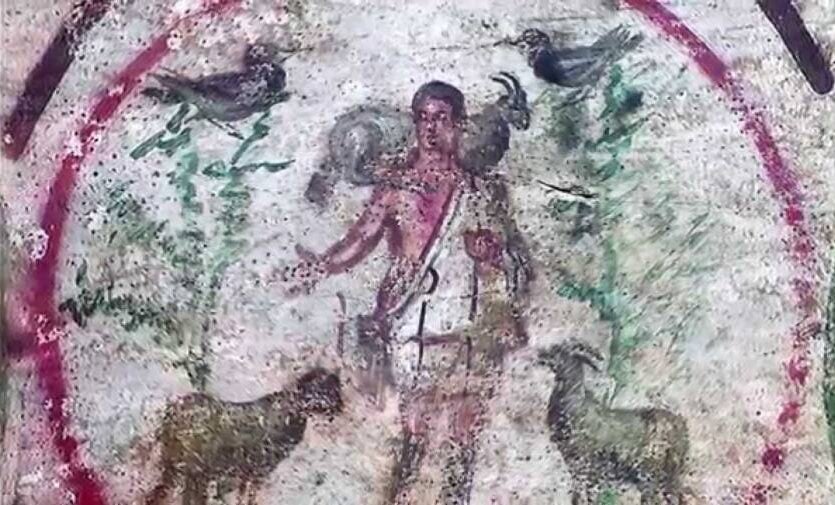
Public DomainThe Good Shepard at the Catacombs of Priscilla.
Many of these early Christian works were not made to be historically or biblically accurate. Instead, they were used to identify other Christians and convey Christian theology, making it difficult to glean information about Jesus’s physical appearance from them.
Greek And Roman Influence On Christian Iconography
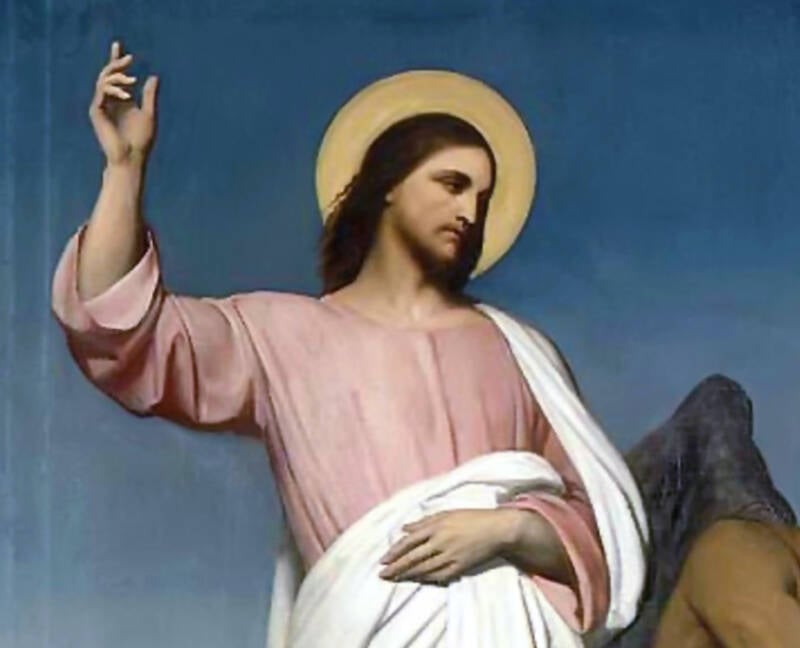
Wikimedia CommonsThe physical appearance of Jesus as depicted in paintings took on a great deal of Roman influence over the centuries.
In 313 C.E., the Edict of Milan legalized Christianity in the Roman Empire, leading to a new wave of Christian art.
Taking inspiration from depictions of imperial Roman leaders and figures like Alexander the Great, the art of Jesus became more grand and elaborate, picturing Jesus as a lord of the Earth and a conqueror.
And while early works saw Jesus depicted as a youth with short hair and no facial hair, depictions at this time preferred an older Jesus, one with a long beard and long hair. This period also saw the introduction of the gold halo behind Jesus’ head.
In the Eastern Christian Church, Jesus’ depictions as a long-haired, bearded man became standard beginning in the 6th century. In the West, this image did not become popular until the 12th century.
By the Middle Ages, it was commonplace across the Christian world to depict Jesus as a long-haired, bearded man with light skin. It wouldn’t be until the Renaissance that artistic styles would make major changes.
Views On Jesus During The Renaissance And The Rebirth Of Christian Art
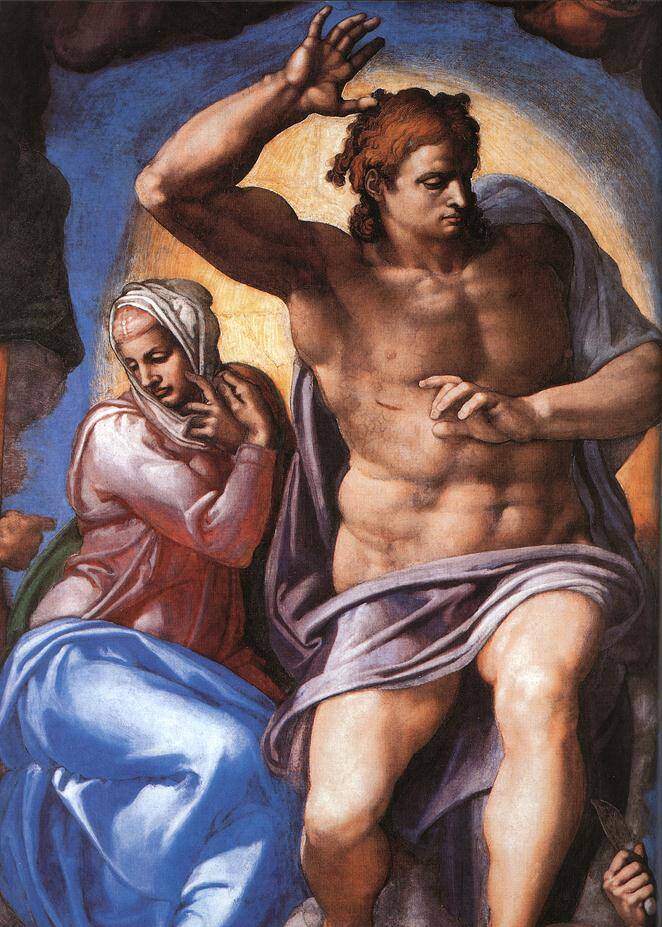
Public DomainJesus and Mary in Michelangelo’s The Last Judgement.
The Renaissance, a period of social, cultural, and religious revival in Europe, began in the early 15th century. The movement aimed to pull the continent out of the Dark Ages by appealing to and imitating its classical antiquity roots.
During this time, artists like Leonardo da Vinci, Michelangelo, and Raphael revolutionized Christian art.
For example, Leonardo da Vinci in his The Last Supper, depicted Jesus as a beautiful, radiant, and soft figure.
In Michelangelo’s The Last Judgement in the Sistine Chapel, Jesus is physically fit and beardless, bearing a resemblance to ancient Greek sculptures.
Among the Protestants, religious art pulled away from grandeur and sensationalism and was replaced by more modest and personal depictions of Christian theology.
How European Colonialism Shaped Our Understanding Of What Jesus Looked Like
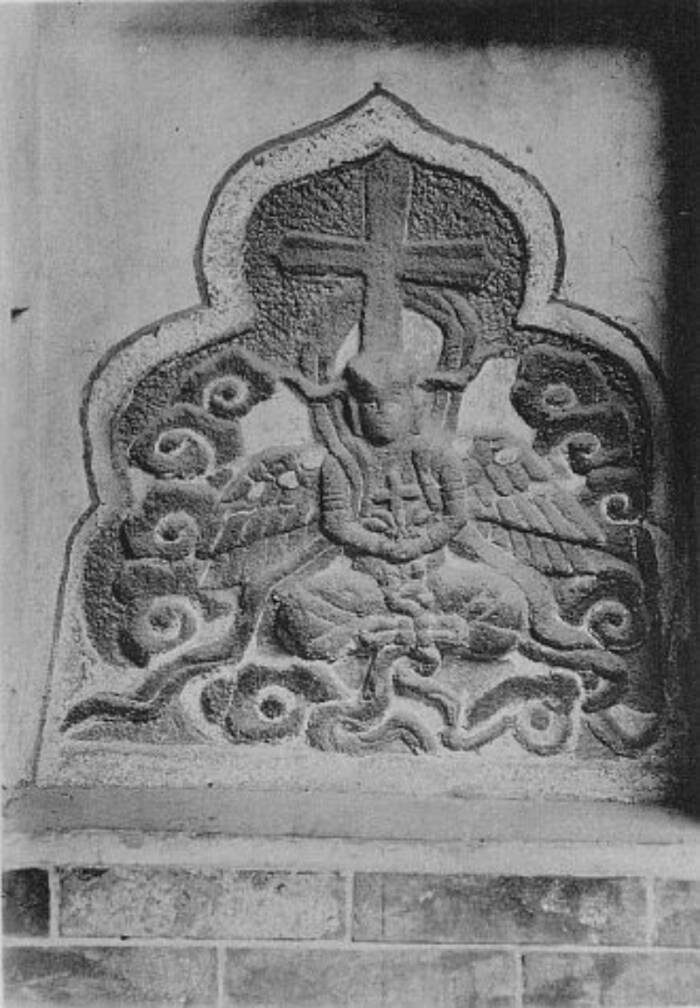
Public DomainChristian iconography in the Xi’an Stele from the 9th century C.E.
Since the 6th century C.E., images of Jesus have appeared in areas beyond Europe, northern Africa, and the Middle East.
Even as far as China, depictions of Jesus have been found dating back to the 7th century. The Xian Tomb Murals in Xian, China hold the remains of a Persian Christian missionary. One of the murals is believed to depict Jesus holding a cross in a cross-legged position.
However, while some cultures created artistic representations of Jesus that blended European and native influences, the European image of Jesus was also used to create social divides and hierarchies.
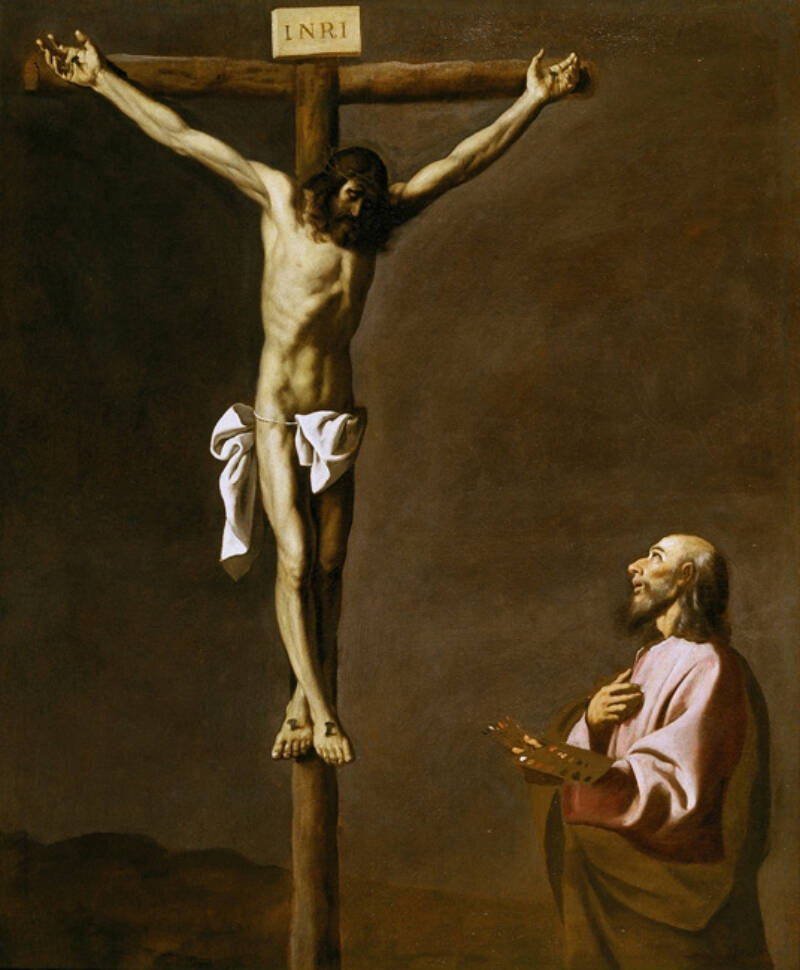
National Gallery of ArtFrancisco de Zurbarán’s Saint Luke Contemplating the Crucifixion, c. 1630.
Jesuit missionaries in particular were responsible for sharing an image of Jesus that bore similarities to those created during the Renaissance.
In Latin America, the Spaniards created a caste system divided into four categories: Spaniards born in Spain, Spaniards born in the New World, indigenous people, and enslaved Africans. Teaching theology with a distinctly white, European-looking savior figure helped reinforce this racial divide in the Spanish colonies.
Regional Differences In Depictions Of Jesus’ Appearance

Jangheung Catholic ChurchA Korean depiction of Jesus’ ascension.
Despite efforts to standardize the image of Jesus, regional differences in artworks reflect the culture, traditions, and values of the people who created them.
In the Ethiopian Orthodox Church, Jesus is often depicted with dark skin and almond-shaped eyes, a portrayal that resonates with the local population’s features and cultural identity. This continues in modern African art, where Jesus is shown with darker skin.
In Korea, Jesus is frequently depicted with Asian facial features while wearing traditional hanbok.
Even in Latin America, where Spanish missionaries imposed a Eurocentric image of Jesus, local adaptations have flourished. In places like Peru, Bolivia, and Mexico, indigenous depictions of Jesus with local features or in traditional dress underscore the blending of Christian faith with native traditions, emphasizing that it is not Jesus’ appearance that matters, but the transformative power of his message.
The Scientific Interpretation Of Jesus’ Physical Appearance
Forensic Anthropology Reconstructs Jesus’ Appearance
New developments in forensic anthropology have allowed researchers to form a better idea of the face of Jesus.
The field of forensic anthropology studies human remains and their role in an event, combining anatomical sciences with history and archaeology. One of its key techniques is forensic facial reconstruction, which is used to recreate the physical appearance of individuals based on their skeletal remains.
However, without the remains of Jesus, how is it possible for forensic anthropology to accurately recreate the Christian savior’s appearance?
Richard Neave Recreates The Face Of Jesus
In 2001, a revolutionary study from Richard Neave, a British forensic artist, created a reconstruction of what Jesus might have looked like based on scientific analysis of other Middle Eastern skulls from the 1st century.
Using an Israeli skull dating back to the first century, Neave and his team used computer programs, clay, and their knowledge of historical Jewish and Middle Eastern features to create a face that might have hypothetically belonged to a neighbor of Jesus — or perhaps even Jesus himself.
Neave’s work appeared on the BBC documentary series Son of God, which chronicles the life of Jesus using scientific and historical evidence. Jean-Claude Bragard, the producer of the series, said of the recreation, “Using archaeological and anatomical science rather than artistic interpretation makes this the most accurate likeness ever created.”
He continued, “It isn’t the face of Jesus, because we’re not working with the skull of Jesus, but it is the departure point for considering what Jesus would have looked like.”
Science Reveals The Eye, Hair, And Skin Color Of Jesus
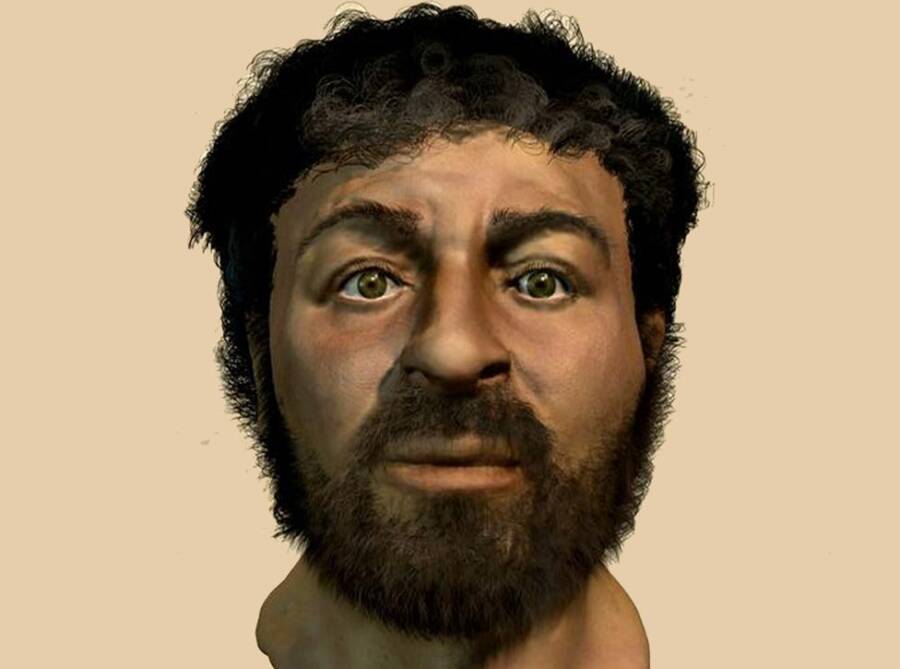
BBCA forensic reconstruction of the face of a 1st-century man from Judea.
At the end of Richard Neave’s study, he concluded that the Jesus depicted in European art was quite different from his reconstruction. Instead, his depiction showed a man with tan, olive-toned skin. He had dark, curly hair cropped close to his head, dark eyes, and a short beard.
In 2015, Neave and a group of medical artists published further findings after examining Semite skulls. They found that Jesus likely had a wide face, dark eyes, short dark hair, a bushy beard, and tanned skin.
In 2018, Joan Taylor, a professor of early Christianity and Second Temple Judaism at King’s College London, published What Did Jesus Look Like?, a historical study into Christ’s appearance. Drawing on textual and archaeological sources, Taylor suggests that Jesus was around 5’5″ tall — the average height seen in male skeletons from the same time and place.
Ancient DNA Studies Offer Clues About Jesus’ Physical Appearance
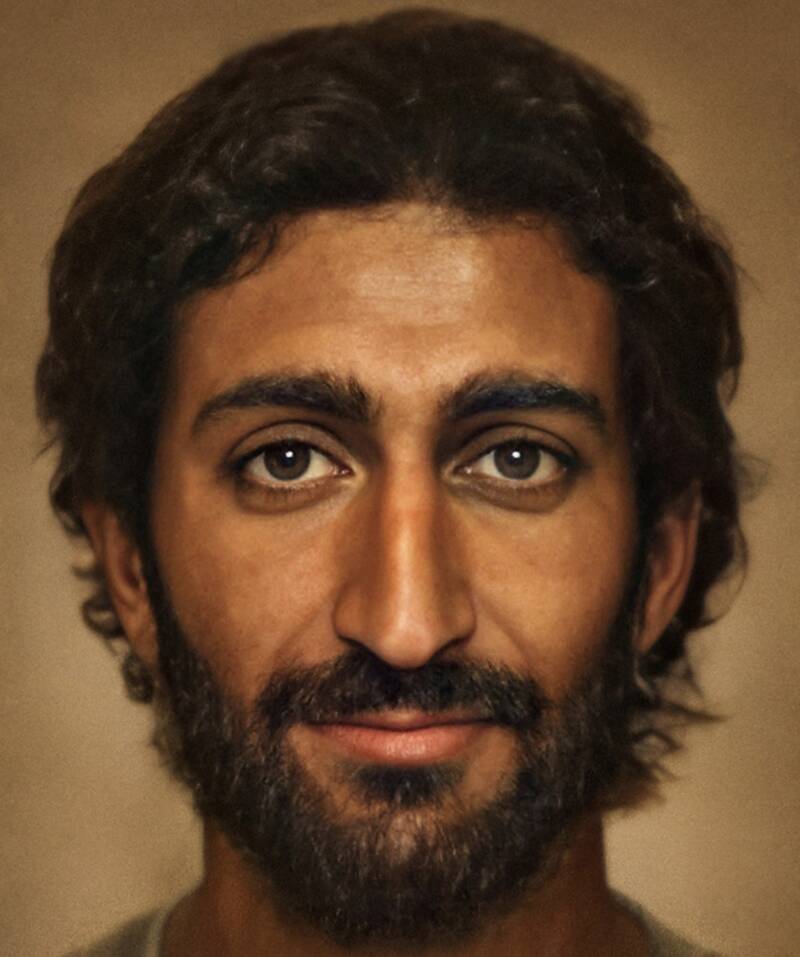
Bas UterwijkThe artist Bas Uterwijk created a photorealistic depiction of Jesus based on DNA and forensic anthropology.
While forensic anthropology has shed the most light on the face of Jesus, DNA studies have also revealed fascinating information about what he may have looked like.
In 2017, Harvard University and the Israel Antiquities Authority performed DNA analysis on human remains exhumed from Philistine cemetery at Ashkelon, Israel. The remains spanned across centuries but included individuals from the time of Jesus.
DNA analysis showed that people living in 1st century Judea would have had Mediterranean genetic traits such as dark hair and dark eyes.
These findings were supported by another study a year later. Éadaoin Harney, lecturer in the Department of Human Evolutionary Biology at Harvard University, studied the DNA of ancient Levantine populations from the Neolithic to the Roman period and found that Jesus likely had physical characteristics typical of Mediterranean populations.
Historical Evidence Paints The Most Accurate Picture Of Jesus
A Dive Into Jesus’ Height And Physique
Both historical and scientific evidence support the idea that Jesus was likely not very tall. Biblical accounts offer a glimpse of this, recalling how Jesus was able to get lost in crowds, indicating he may have been of average or shorter than average height.
Studies of ancient populations in Judea suggest that the average male height during the time of Jesus was approximately 5 feet 5 inches. Given that Jesus would have been a member of this population, it is unlikely that he was significantly taller than the average Judean man.
When it comes to Jesus’ physique, however, ideas remain more speculative. The most convincing evidence regarding his body type comes from the Bible itself. Descriptions of Jesus as a carpenter and a wanderer imply that he would have had a muscular build and a tanned complexion from his outdoor labor in the sun.
“Jesus was a man who was physical in terms of the labor that he came from,” Taylor tells Live Science. “He shouldn’t be presented as… someone who was living a soft life, and sometimes that’s the kind of image we get.”
Exploring Early Jewish Fashion And Clothing
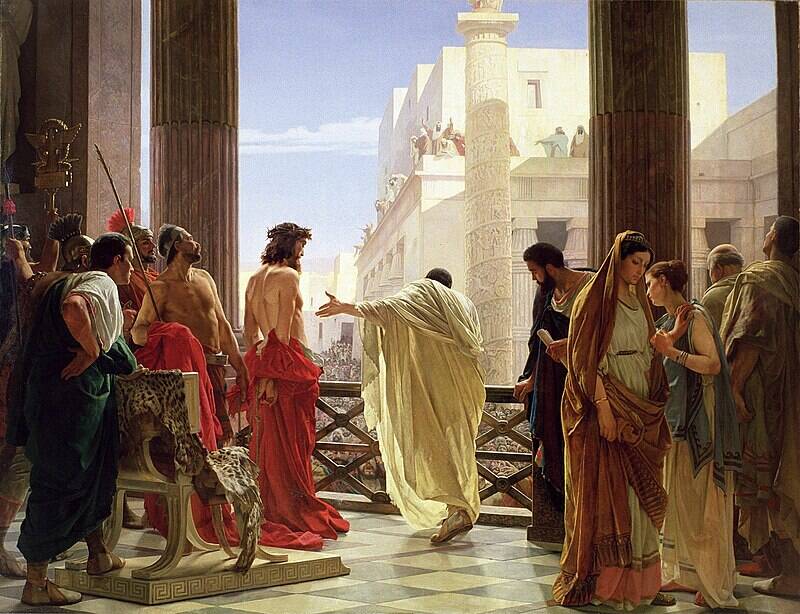
Public DomainAntonio Ciseri’s 1871 depiction of Pontius Pilate presenting Jesus to the public before execution.
Evidence regarding what Jesus would have worn is almost entirely historical, as the Bible only briefly mentions his attire. The Gospel accounts describe Jesus wearing a robe (likely a chiton), a common garment for men in the Roman era, and sandals on his feet.
The Bible does not provide an extensive description of Jesus’ clothing but emphasizes his modesty in appearance and dress. Given this, it is unlikely that Jesus wore expensive or elaborate garments, such as tunics made of Tyrian purple, which were typically worn by the elite in the ancient world.
Historically, Jesus would have also likely worn a himation, a simple cloak used to cover tunics and provide warmth in cooler weather. This outer garment was common for men in the Mediterranean world during Jesus’ time and would have been practical for his daily life, especially during his travels.
Was Jesus Physically Attractive According To The Bible?
While beauty is proverbially in the eye of the beholder, Isaiah 53:2 suggests that Jesus had no majestic form or beauty that would have attracted attention, indicating that his appearance was likely ordinary by most standards.
Why Is Jesus Sometimes Depicted With Long Hair?
During the Middle Ages, artists began to portray Jesus with long hair and a beard, likely influenced by Roman traditions that depicted important philosophers and deities with long hair.
How Do Different Cultures Depict Jesus?
Different cultures depict Jesus according to their own ethnic backgrounds and artistic traditions to express a sense of connection to the religious figure regardless of race or ethnicity.
Did Jesus Have A Physical Sign Of His Divinity?
No. In fact, Jesus was described as being particularly ordinary and relatable by his followers. Instead, his divinity is portrayed through his actions, teachings, and miracles.
Why Is Jesus Portrayed In So Many Different Ways?
Jesus is portrayed in many different ways to reflect the cultural, ethnic, and historical contexts of the artists and communities creating the depictions.
Are Facial Reconstructions Of Jesus Accurate?
Because the remains of Jesus have never been found (though some say his tomb has), facial reconstructions are based on skulls of other Judeans from the same period. This fact does make any facial reconstructions purely speculative in nature.
Why Is Jesus Sometimes Depicted With Blonde Hair And Blue Eyes?
Jesus is sometimes depicted with blonde hair and blue eyes due to artistic conventions in Europe during the Renaissance, where artists often portrayed him with European features to align with their own cultural ideals. Euro-centric depictions of Jesus have also been used to reinforce caste systems and racial divides during the Age of Colonialism.
After learning about the real face of Jesus Christ, read about Jesus’ real name, when he was born, and where he was born. Finally, learn about how old the Virgin Mary was when she had Jesus.





